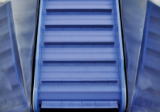conveyor belt classification

Conveyor belts are generally classified according to the presence or absence of traction elements.
A conveyor belt with a traction member generally includes a traction member, a bearing member, a driving device, a tensioning device, a redirecting device and a supporting member. Traction parts are used to transmit traction force, and can use conveyor belts, traction chains or steel wire ropes; load-bearing members are used to hold materials, such as hoppers, brackets or spreaders, etc.; Brakes (stoppers) and other components; the tensioning device generally has two types: screw type and heavy hammer type, which can keep the traction member in a certain tension and sag to ensure the normal operation of the conveyor belt; the supporting member is used to support the traction member or load Components, rollers, etc. can be used.
The structural characteristics of the conveyor belt equipment with traction parts are: the conveyed materials are installed in the bearing member connected with the traction parts, or directly on the traction parts (such as conveyor belts), and the traction parts bypass the head and tail of each roller or sprocket. Connected to form a closed loop including a loaded branch that transports materials and an unloaded branch that does not transport materials, and uses the continuous movement of the traction member to transport materials.
There are many types of conveyor belt equipment of this type, mainly including belt conveyors, slat conveyors, trolley conveyors, escalators, moving walks, scraper conveyors, buried scraper conveyors, bucket conveyors, bucket elevators , hanging conveyors and aerial ropeways, etc.
The structural composition of conveyor belt equipment without traction parts is different, and the working components used to transport materials are also different. Their structural characteristics are: using the rotary motion or reciprocating motion of the working member, or using the flow of the medium in the pipeline to transport the material forward. For example, the working member of the roller conveyor is a series of rollers, and the rollers rotate to transport the material; the working member of the screw conveyor is a screw, and the screw rotates in the trough to push the material along the trough; the work of the vibrating conveyor The component is a trough, and the trough reciprocates to transport the materials placed in it.
A conveyor belt with a traction member generally includes a traction member, a bearing member, a driving device, a tensioning device, a redirecting device and a supporting member. Traction parts are used to transmit traction force, and can use conveyor belts, traction chains or steel wire ropes; load-bearing members are used to hold materials, such as hoppers, brackets or spreaders, etc.; Brakes (stoppers) and other components; the tensioning device generally has two types: screw type and heavy hammer type, which can keep the traction member in a certain tension and sag to ensure the normal operation of the conveyor belt; the supporting member is used to support the traction member or load Components, rollers, etc. can be used.
The structural characteristics of the conveyor belt equipment with traction parts are: the conveyed materials are installed in the bearing member connected with the traction parts, or directly on the traction parts (such as conveyor belts), and the traction parts bypass the head and tail of each roller or sprocket. Connected to form a closed loop including a loaded branch that transports materials and an unloaded branch that does not transport materials, and uses the continuous movement of the traction member to transport materials.
There are many types of conveyor belt equipment of this type, mainly including belt conveyors, slat conveyors, trolley conveyors, escalators, moving walks, scraper conveyors, buried scraper conveyors, bucket conveyors, bucket elevators , hanging conveyors and aerial ropeways, etc.
The structural composition of conveyor belt equipment without traction parts is different, and the working components used to transport materials are also different. Their structural characteristics are: using the rotary motion or reciprocating motion of the working member, or using the flow of the medium in the pipeline to transport the material forward. For example, the working member of the roller conveyor is a series of rollers, and the rollers rotate to transport the material; the working member of the screw conveyor is a screw, and the screw rotates in the trough to push the material along the trough; the work of the vibrating conveyor The component is a trough, and the trough reciprocates to transport the materials placed in it.